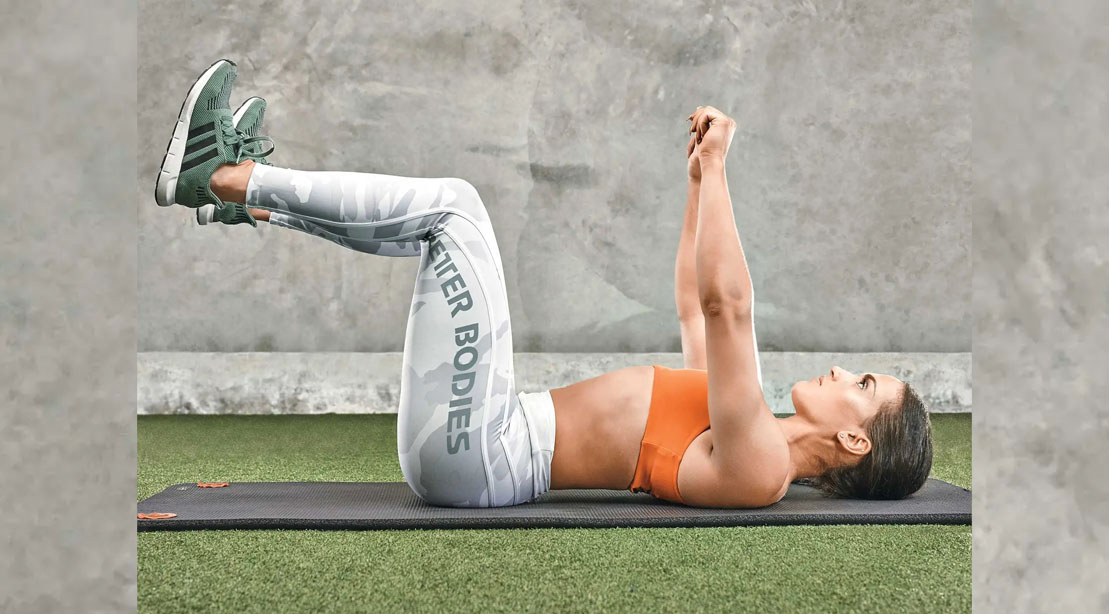The dead bug exercise is a silly name for any exercise, there’s no getting around that. The movement doesn’t appear to do anything that beneficial, which is why many lifter may shrug it off and ignore incorporating it into their routine.
That’s a real shame because when the dead bug is performed correctly, it’s an exercise that checks off a lot of boxes that strength-training athletes require.
You’ll see very few people performing the dead bug on social media because it looks like your arm and leg are flailing about and nothing is happening. But this couldn’t be further from the truth, as the dead bug is almost the perfect core stability exercise that you are not doing but should be.
Here this article will explain what it is, how to do it, the muscles trained, benefits and mistakes, and progressions to further strengthen your core.
WHAT IS THE DEADBUG EXERCISE?
The reason it’s called a dead bug is that you know, it resembles a dead bug on its back. The dead bug involves you lying on your back and performing contralateral (opposite arm and leg) movement while keeping your entire back on the ground. At its core (see what I did there) the deadbug is an anti-extension exercise. But it trains all 360 degrees of your core— the anterior and posterior core, the obliques, and your hips. Making it the total package of core exercises.
HOW TO DO THE DEADBUG EXERCISE
The dead bug seems simple enough but the devil is in the details. Here is how to properly perform the deadbug.
- Lie on your back and take your feet off the ground and bend the knee at 90 degrees with your toes pointed up.
- Extend your arms towards the ceiling with your hands directly above your shoulders. Now you look like a dead bug.
- Flatten your lower back by performing a posterior pelvic tilt. Maintain this the whole time.
- Take a deep breath in through the nose feeling 360-degree expansion.
- Extend your left arm behind you and your right leg in front of you at the same time and breathe out with your back glued to the ground.
- Return to the starting position and repeat on the other side.
MUSCLES TRAINED BY THE DEADBUG EXERCISE
The deadbug is a coordinated full-body exercise that focuses on core stability and involves multiple muscles. Here are the upper and lower body muscles trained with the deadbug.
Upper Body
- Posterior deltoids
- Anterior deltoids
- Pectorals
These muscles are involved with bringing the arms overhead with shoulder flexion and bringing the arm back to the starting position with shoulder extension.
Lower Body
- Erector spinae (Lower back)
- Obliques
- Rectus abdominis
- Transverse abdominis
- Hip Flexors
- Quadriceps
The core muscles prevent extension and rotation of the lower back when moving contralaterally.
BENEFITS OF THE DEADBUG EXERCISE
The deadbug is not a sexy exercise that will instantly give you a six-pack. But when performed correctly you’ll feel the true function of the core—which is to prevent movement while you’re moving.
Here are some other important benefits of performing the deadbug.
- Improves coordination: The basis of human movement is contralateral movement—opposite limbs moving in the same motion, like crawling. This is something taken for granted and some people lose it because of inactivity. The dead bug reinforces this contralateral movement for better overall coordination.
- Encourages Good Posture: The deadbug encourages a neutral spine and better posture because you posteriorly tilt your pelvis to flatten your lower back. As you receive feedback from the floor, you’ll know when your lower back slips into extension. The dead bug makes you more aware of your posture and what it feels like to keep a neutral spine.
- Improved Core Stability: There are tons of exercises that improve core stability with the dead bug being one of them. When you combine contralateral movement with your breath, you’ll feel the true meaning of the function of your core, resisting movement. If you cannot keep a neutral spine and your core stable while performing the dead bug, then good luck doing it under load.
- Reinforces Correct Breathing Patterns: Deep breathing via the diaphragm is how you are meant to breathe. However, there is nothing wrong with chest breathing when you need air quickly when being chased by a wild animal. But when performing big lifts taking a deep belly breath protects your spine and provides the tension necessary to make the lift. Because your arms are above your head and moving, this encourages belly, rather than chest breathing.
COMMON FORM MISTAKES
The dead bug is a simple core exercise and is easy to teach and perform but that doesn’t mean some perform it poorly. Here are some common mistakes that will stop you from getting the best out of this exercise.
- Lower Back Extends: When extending the opposite arm and leg, your back loses contact with the ground due to a lack of shoulder or hip mobility. If this happens, stay within a range of motion where your core resists extension.
- Don’t Rush: Lifters tend to rush this exercise and flail their arms and legs around while rushing through their set. Don’t do that. There is a loss of tension, and the benefit of this exercise disappears. Instead, slow down your breath, and feel the core magic.
- Keep Your Head Down: Some lifters like to watch themselves do the deadbug which cranks the neck rounds the cervical spine and there is a loss of neutral spine. Instead, look straight up, pick a spot on the ceiling slightly behind you and resist the temptation to watch yourself.
DEAD BUG VARIATIONS
The deadbug exercise like all good exercises is regressed or progressed. When you have mastered the bodyweight version here are three progressions to soup up your deadbug.
